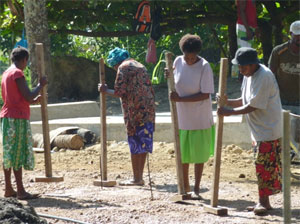AusAID and Vanuatu's Public Works Department are together pioneering an approach to tropical road construction which will create local contract and employment opportunities for island communities.
The contractors get to learn more about some of the materials locally available to them, and are trained in 'best use' techniques. Cobble and dry stone pavements, bitumen surfaces, corneous gravel pavement and reinforced concrete have all been tried. Each is useful in its place.
Local communities are employed as workers and are delighted to take on the variety of jobs needed as soon as they realise they can do some jobs better than heavy machinery. Relying mainly on people rather than heavy equipment is also better because the equipment tends to disappear for years after every major undertaking - off to another island for a bigger chore.
Women are also able to earn money on these road works. They use the greater part of their earnings to buy goods from village stores and to help with schooling costs, which benefits all three islands.
AusAID road making expertise and funds were first brought together with local contractors on the Lakatoro Loop Road (Malekula), and Imanaka to Lowiaru junction (Tanna) projects.
The projects were a showcase for different techniques, not only of road construction, but for effective drainage. If the drainage is not done properly, community achievements are quickly washed away when the wettest weather comes.
At the launch of the Australia-funded roads project, then-Infrastructure Minister Serge Vohor said "Intense rainfall has caused severe creek and river flooding, which has caused deaths in the past and continues to be dangerous for young children and mothers who need to cross the creeks to get to schools and hospitals".
There are also steep slopes, inconsistent materials and a need for massive drainage. Despite this, the Tannese (both the local contractors and the labourers) are taking on their road project with strong determination.
Some machine based operations had to be included, but apart from a national contractor to supervise, there are ten island based contractors busily working on the job.
The Island based contractors know what type of downpours they get and the damage it does to their roads. They also know the new wet season is just beginning, so they are working hard to make good progress while they can.

